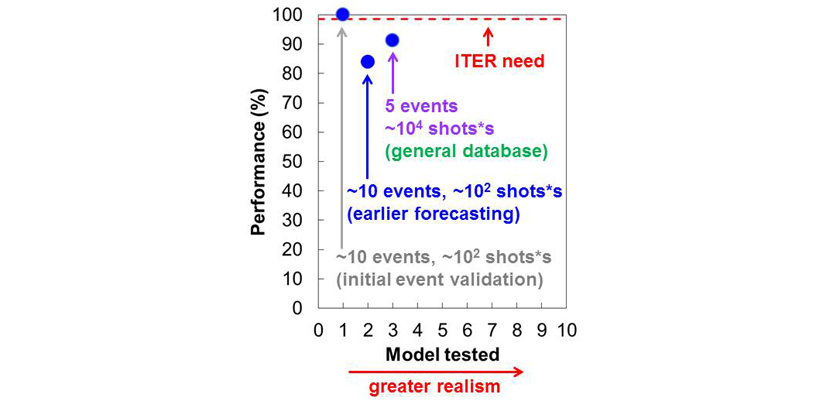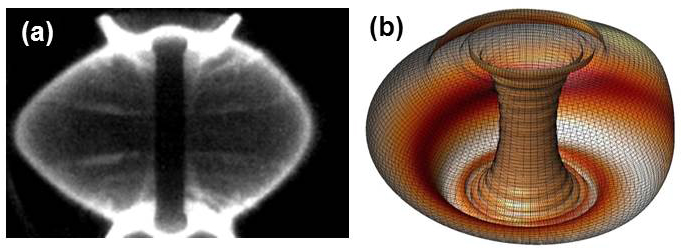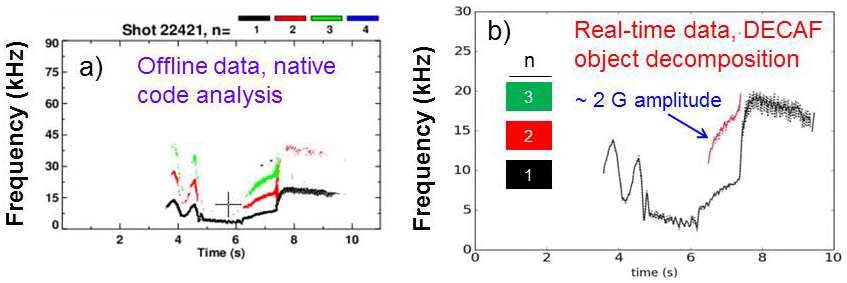Speaker
Description
Disruption prediction and avoidance is critical for ITER and reactor-scale tokamaks to maintain steady plasma operation and to avoid damage to device components. The present status and results from the disruption event characterization and forecasting (DECAF) research effort (1) are shown for multiple tokamak devices. Access to the full KSTAR, MAST, NSTX, AUG, TCV, and DIII-D databases is presently available. The DECAF paradigm is primarily physics-based and provides quantitative disruption prediction for disruption avoidance. DECAF automatically determines the relation of events leading to disruption and quantifies their appearance to characterize the most probable and deleterious event chains, and also to forecast their onset.
Present DECAF analysis of KSTAR, MAST, and NSTX databases shows low disruptivity paths to high beta operation. The disruptivity does not increase at high normalized beta, $\beta_N$, as is often mistakenly expected. Automated analysis of rotating MHD modes now allows the identification of disruption event chains for several devices including coupling, bifurcation, locking, and potential triggering by other MHD activity. DECAF can now provide an early disruption forecast (on transport timescales) allowing the potential for disruption avoidance through profile control. The first hardware to allow real-time evaluation of this activity on KSTAR was installed in 2019. The first real-time data and offline test results are shown below. DECAF event characterization and event chain analysis shows that disruption forecasting analysis often starts during plasma operational states and at parameters that appear safe. This fact is completely missed by “disruption database” studies that only process data near the disruption time.
Disruption prediction research using DECAF also allows quantifiable figures of merit (i.e. the plasma disruptivity) to provide an objective assessment of the relative performance of different models. This allows an assessment of how well the predictor performs compared to ITER needs. Figure 1  shows a progression of DECAF disruption forecasting models. The earliest models included about 10 events and were run on databases for which the events that led to the disruption were known and yielded very high performance (e.g. 100% true positives). A next evaluation of models focused on earlier forecasting once the first physics forecasting model was implemented in the code. True positives were found to be ~84%, which was a measure mainly of the single forecasting model. Forecasting models continue to be added to improve that performance. Recent code testing has been on large databases ~ 10,000 shot*seconds of plasma run time tested (Figure 1). This was done with a smaller number of events due to computer limitations. With 5 events, applied to all plasma shots from an NSTX database, DECAF shows performance levels of over 91% true positive disruption predictions. False positives in this analysis reached 8.7% which is fairly high. Present code development that allows the events to poll each other will improve the false positive tally.
shows a progression of DECAF disruption forecasting models. The earliest models included about 10 events and were run on databases for which the events that led to the disruption were known and yielded very high performance (e.g. 100% true positives). A next evaluation of models focused on earlier forecasting once the first physics forecasting model was implemented in the code. True positives were found to be ~84%, which was a measure mainly of the single forecasting model. Forecasting models continue to be added to improve that performance. Recent code testing has been on large databases ~ 10,000 shot*seconds of plasma run time tested (Figure 1). This was done with a smaller number of events due to computer limitations. With 5 events, applied to all plasma shots from an NSTX database, DECAF shows performance levels of over 91% true positive disruption predictions. False positives in this analysis reached 8.7% which is fairly high. Present code development that allows the events to poll each other will improve the false positive tally.
There is an extensive physics research effort supporting DECAF model development. Two recent studies are summarized here. First, analysis of high performance KSTAR experiments using TRANSP shows non-inductive current fraction has reached 75%. Resistive stability including $\Delta$’ calculation by the Resistive DCON code is evaluated for these plasmas using kinetic equilibrium reconstructions with magnetic field pitch angle data to determine capability for instability forecasting. (2) To design experiments for the 2019 KSTAR run, “predict-first” TRANSP analysis was performed showing that with the newly-installed 2nd NBI system (assuming usual energy confinement quality and Greenwald density fraction), 100% non-inductive plasmas scenarios are found in the range $\beta_N$ = 3.5–5.0. These plasmas will provide a unique long pulse (~20s) database for disruption forecasting studies. Second, new analysis of MAST plasmas has uncovered for the first time global MHD events at high $\beta_N$ identified as resistive wall modes (RWMs). A stability analysis of MAST plasmas shows a significant ballooning shape of the three-dimensional RWM eigenfunction that compares well to fast camera images (Figure 2).  This new result shows that the MAST RWM eigenfunction shape and growth rate appear significantly altered by the location of conducting structure compared to results from NSTX, which shows a much more spherical shape due to close-fitting copper plates. (3) The conducting wall stabilizing effect on the kink mode is computed to be relatively small in MAST. The plasma with an unstable RWM has a computed no-wall $\beta_N$ limit of 5.0 and a with-wall limit of 5.16. Another new result of this analysis shows that kink mode stabilization was primarily due to the vacuum vessel in MAST. In contrast, design equilibria of MAST-U plasmas show a significant increase in kink stabilization due to the addition of stainless steel divertor plates. The analysis including 3D conducting structure shows an increased stabilized range of $\beta_N$ = 3.8 – 5.7. MAST-U design equilibria with closer plasma-plate coupling show higher with-wall $\beta_N$ limits.
This new result shows that the MAST RWM eigenfunction shape and growth rate appear significantly altered by the location of conducting structure compared to results from NSTX, which shows a much more spherical shape due to close-fitting copper plates. (3) The conducting wall stabilizing effect on the kink mode is computed to be relatively small in MAST. The plasma with an unstable RWM has a computed no-wall $\beta_N$ limit of 5.0 and a with-wall limit of 5.16. Another new result of this analysis shows that kink mode stabilization was primarily due to the vacuum vessel in MAST. In contrast, design equilibria of MAST-U plasmas show a significant increase in kink stabilization due to the addition of stainless steel divertor plates. The analysis including 3D conducting structure shows an increased stabilized range of $\beta_N$ = 3.8 – 5.7. MAST-U design equilibria with closer plasma-plate coupling show higher with-wall $\beta_N$ limits.
.
Real-time DECAF analysis is now being constructed for KSTAR. The first of several real-time computers and diagnostic interfaces has been installed to detect and decompose rotating MHD activity in the device. Sixteen channels of a toroidal array of magnetic probes have been acquired in real-time during MHD activity (Figure 3).  Offline DECAF analysis of the real-time signals shows that the mode decomposition and DECAF object decomposition replicates the local KSTAR spectrogram analysis (Figure 3). The DECAF object decomposition is directly used to produce a warning level for MHD activity shown to provide an early warning forecast (~ 300 ms) for mode locking and subsequent disruption in KSTAR, potentially allowing active profile control to avoid the mode. The real-time hardware includes a field-programmable gate array chip to allow the computation of FFTs used for mode decomposition in real time.
Offline DECAF analysis of the real-time signals shows that the mode decomposition and DECAF object decomposition replicates the local KSTAR spectrogram analysis (Figure 3). The DECAF object decomposition is directly used to produce a warning level for MHD activity shown to provide an early warning forecast (~ 300 ms) for mode locking and subsequent disruption in KSTAR, potentially allowing active profile control to avoid the mode. The real-time hardware includes a field-programmable gate array chip to allow the computation of FFTs used for mode decomposition in real time.
*Supported by U.S. DOE grants DE-SC0016614, DE-SC0018623, and DE-FG02-99ER54524
(1) S.A. Sabbagh, J.W. Berkery, Y.S. Park, et al., IAEA FEC 2018 (Gandhinagar, India), paper EX/P6-26.
(2) Y. Jiang, S.A. Sabbagh, Y.S. Park, et al., submitted to this conference.
(3) S.A. Sabbagh, J.W. Berkery, R.E. Bell, et al., Nuclear Fusion 46 (2006) 635.
| Affiliation | Columbia University |
|---|---|
| Country or International Organization | United States |
